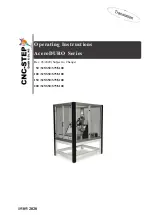
IDT Non-Transparent Mode Operation
PES16NT2 User Manual
10 - 9
April 15, 2008
Notes
transparent bridge endpoint generates a single MSI message for all interrupt sources and this message is
only generated when a falling edge would have occurred on a legacy PCI INTx# pin that corresponds to the
MSI request value
.
1
All of the interrupt sources which map to a legacy interrupt INTx are logically ORed to produce an
INTx
request value
. Whenever the I
NTx request value
transitions from false (i.e., no request) to true, an
ASSERT_INTx message is generated (i.e., whenever a falling edge would have occurred on a legacy
INTx# pin). Whenever the
INTx request value
transitions from true to false, a DEASSERT_INTx message is
generated (i.e., on a rising edge of a legacy INTx# pin).
Each interrupt source in the INTSTS register may be masked at any time by setting the corresponding
field in the INTCTL0 or INTCTL1 register to “disabled.” This enables servicing of INTx and MSI interrupts
using the standard per-vector masking approach outlined in “Servicing MSI and MSI_X Interrupt” on page
251 of the PCI Local Bus specification revision 3.0.
Non-Transparent Bridge TLP Processing
The PES16NT2 supports two forms of very basic processing on TLPs that flow through the non-trans-
parent bridge. TLPs generated by the internal or external NTB endpoints are not affected by the TLP
processing configuration fields described below. When the Force Relaxed Ordering (FRO) bit is set in the
TLP Processing Control (TLPPCTL) register, the value of the relaxed ordering attribute of TLPs flowing
through the NTB is set to the value dictated by the Relaxed Ordering Modification (ROM) field in the
TLPPCTL register. This transformation is only performed on TLPs in which the relaxed ordering attribute is
applicable:
–
The relaxed ordering attribute is applicable to all TLPs except: configuration requests, I/O
requests, memory requests that are Message Signaled Interrupts (MSIs), and Message requests
(except where specifically permitted).
–
Since MSIs cannot be distinguished from memory write transactions by the switch, the relaxed
ordering attribute of MSIs will be modified.
When the Force No-Snoop (FNS) bit is set in the TLP Processing Control (TLPPCTL) register, the value
of the no-snoop attribute of TLPs flowing through the NTB is set to the value dictated by the No-Snoop
Modification (NSM) field in the TLPPCTL register. This transformation is only performed on TLPs in which
the no-snoop attribute is applicable. The no-snoop attribute is applicable to all TLPs except: configuration
requests, I/O requests, memory requests that are Message Signaled Interrupts (MSIs), and Message
requests (except where specifically permitted). Since MSIs cannot be distinguished from memory write
transactions by the switch, the no-snoop attribute of MSIs will be modified.
Configuration
For the non-transparent bridge to function properly, the port C PCI-PCI bridge must be properly config-
ured. Its configuration is the same as in transparent mode and system software should ensure that transac-
tions are properly routed to the internal NTB endpoint. Thus, the issue of NTB configuration relates to how
the internal and external endpoints are configured. The organization of the port C PCI-PCI bridge configura-
tion space is described in section section on page 10-19.
All normal PCIe endpoint configuration must be performed before the NTB will forward transactions. For
example, the Memory Access Enable (MAE) and Bus Master Enable (BME) bits must be set in the internal
and external PCI command registers (i.e., PCIE_PCICMD and PCEECMD) before memory transactions are
routed through the non-transparent bridge.
Reading the Non-Transparent Bridge Endpoint Identification (NTBEPID) register returns the bus, device
and function number of the last configuration write to the non-transparent bridge. This may be used by soft-
ware to determine the ID of the non-transparent bridge.
1.
Note that INTx# is active low while
MSI request value
is active or true when high.
Содержание 89HPES16NT2
Страница 14: ...DT List of Figures PES16NT2 User Manual viii April 15 2008 Notes...
Страница 20: ...IDT Register List PES16NT2 User Manual xiv April 15 2008 Notes...
Страница 32: ...IDT PES16NT2 Device Overview PES16NT2 User Manual 1 12 April 15 2008 Notes...
Страница 44: ...IDT Clocking Reset and Initialization Clock Operation PES16NT2 User Manual 2 12 April 15 2008 Notes...
Страница 50: ...IDT Link Operation PES16NT2 User Manual 3 6 April 15 2008 Notes...
Страница 62: ...IDT Power Management PES16NT2 User Manual 5 4 April 15 2008 Notes...
Страница 78: ...IDT SMBus Interfaces PES16NT2 User Manual 6 16 April 15 2008 Notes...
Страница 83: ...IDT NTB Upstream Port Failover PES16NT2 User Manual 7 5 April 15 2008 Notes...
Страница 84: ...IDT NTB Upstream Port Failover PES16NT2 User Manual 7 6 April 15 2008 Notes...
Страница 130: ...IDT Transparent Mode Operation PES16NT2 User Manual 9 44 April 15 2008 Notes...
Страница 284: ...IDT Non Transparent Mode Operation PES16NT2 User Manual 10 154 April 15 2008 Notes...
















































